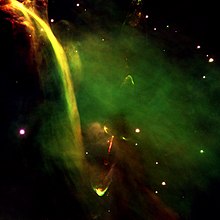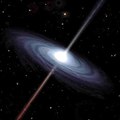User:Idntknw/sandbox
Stellar evolution[1] can be divided into 3 main sequences: Birth, Main Sequence and Death. A star is born from a gas and dust agglomerate found in space called nebula and its created when gravity collapses the gas and dust creating a protostar (beginning of a star) subsequently it grows according to its mass and temperature; eventually the star will die sometimes collapsing on itself and from there it can end in different ways: White dwarfs, Novas, Supernovas, Black Holes[2] and Neutron Stars. Subsequently new stars are born from the remnants.
Stellar Birth[edit]

Stars are born in large clouds of dust called nebulas when the gas and dust begin to collapse under its own gravitational attraction. While the star is collapsing the matter at its core starts heating up: this heated core is known as a protostar[3] and in future will become a star. This core will continue to gather gas and dust, although not all of this gas and dust will become part of the star: some of it might form planets, comets, asteroids or just remain dust.
Main Sequence[edit]
A star the same size as our sun requires roughly 50 million years to go from the nebula collapse to full formation. A star this size will maintain this mature phase (or Main Sequence) for about 10 billion years.Stars produce energy via the nuclear fusion of hydrogen in order to obtain helium deep in their cores the outburst of energy from the star's core provides the necessary pressure to keep the star from collapsing under its own weight, and the energy by which it shines. As shown in the Hertzsprung-Russell Diagram the Main Sequence stars have a wide range of luminosities and colors, and can be classified according to those characteristics. The smallest stars in existence are called red dwarfs and can contain as little as 10% of the sun's mass and emit only 0.01% as much energy therefore they glow very poorly and only reach temperatures between 3000 Kelvin and 4000 Kelvin; Red Dwarfs are the most numerous stars in the Universe and live for tens of billions of years. On the other hand, the biggest stars known as Hypergiants can be 100 or more times bigger than our sun and reach surface temperatures of over 30,000K and they emit hundreds of thousand of times more energy than our sun. Unfortunately though they only live for a few million years. Even though astronomers and scientists believed these stars to be very numerous they are extremely rare and in our galaxy, the milky way there is only a handful of them.[4]
The different fates stars can have[edit]

Generally the bigger the star the shorter its lifespan is, even though all stars except the biggest ones live for billions of years. Once a star has fused all the hydrogen that it contains in its core the nuclear reactions cease, deprived of the fuel and therefore of the energy needed to support the star. Its core begins to collapse into itself and its temperature raises drastically. But since hydrogen is still present in the outer layers of the star the nuclear fusions continue in a shell that surrounds the core. The increasingly hot core also drives the outer layer of the star outwards therefore causing them to cool turning the star into a red giant.
If the star is big enough the heated up collapsing core may become able to support different nuclear reactions for example turning helium into iron. Nonetheless these different nuclear reactions only give the star a temporary truce. Even if slowlier the star’s nuclear fires become more and more unstable sometimes they burn faster other times they die out these different changes cause the star to pulsate and therefore get rid of its outer layers and to concealò itself in a cocoon of gas and dust. What follows depends on the size of the star's core:
Average stars become white dwarfs[edit]

Stars with a mass similar to the one of our sun the repulsion of the star's outer layers continues until the stellar core is exposed, this dead but still extremely hot stellar ember is called a White Dwarf. White Dwarfs are about the same size as planet earth despite the fact that they contain the mass of a star. These stars do not collapse because of the pressure caused by fast moving electrons. The more massive the star's core was the denser the white dwarf will be, hence the smaller the white dwarfs diameter is the larger its mass is. These paradoxical stars are very common and are intrinsically very faint because they are so small and because they lack a source of energy production they tend to fade into oblivion as they cool down. This fate only affects stars with a mass up to 1.4 times that of our Sun.[5]
[edit]
In the case that the White Dwarf forms in a binary or multiple star system it might have a more eventful demise such as a nova. If a white dwarf is close enough to another star its gravity could start absorbing matter (mostly hydrogen) from the outer layers of that star into itself expanding its surface layer. When the White Dwarf has accumulated enough hydrogen on its outer layer a burst of nuclear fusion occurs, this outburst causes the White Dwarf to expel its remaining material and brighten substantially. A couple of days later the Dwarf stops glowing and the cycle starts over. Sometimes if the White Dwarf is near the 1.4 solar limit it may accumulate so much mass that it explodes resulting in a supernova.[6]
Supernovae residues[edit]

Main sequence stars over 8 times the solar mass will eventually die in a gigantic explosion called a supernova. A Supernovae is not just a bigger nova; in a nova only the star's surface collapses, in a supernova instead. In supernovae a very complex series of nuclear reactions leads to the production of iron in the core this means that the star has wrung all the energy it can out of nuclear fusion therefore the star cannot support its weight and the iron core collapses. in a matter of seconds the core shrinks from 5000 miles across to barely a dozen and the temperature reaches peaks of 100 billion degrees or more. the outer layers of the star begin to collapse with the core but are shot out violently by the huge outburst of energy (too high even to be imagined) for a period that varies between days and weeks a supernova can outshine entire galaxies. According to average there is one supernova explosion every hundred years in the average galaxy.
Neutron stars[edit]

If the collapsing stellar core contains between 1.4 and 3 solar masses the collapse will continue until protons and electrons combine thus forming neutrons and therefore a neutron star, these are incredibly dense similarly to an atom's nucleus. because of the fact that its mass is so large but its dimensions are so small its gravitation is immense. Similarly to White Dwarfs if Neutron Stars form in a multiple star system it can steal gas from companion stars. They also have powerful magnetic fields which can accelerate atomic particles around its magnetic poles forming powerful beams of radiation. These beams sweep around the star as it rotates and they act as massive searchlight beams, if one of such beams is pointed in such a way that it points periodically towards earth we see it as regular pulses of radiation that are caused by the magnetic pole sweeping past the line of sight in these cases the Neutron Star is known as a pulsar.[7]
Black holes[edit]

If the stellar core is larger than 3 solar masses it collapses completely to form a black hole; an object that has infinite density and whose gravity is so strong nothing can escape its grasp if too close not even light. Since our instruments are programmed to see photons we are only able to see black holes only indirectly these are possible because the gravitational field black holes have is so powerful that any nearby material -often the outer layers of companion stars -is caught up and dragged in. As a black hole drags matter into it it heats the matter up to enormous temperatures emitting lots of X-rays and Gamma-rays that indicate the presence of the underlying hidden companion.[8]
From the remains new stars can be born[edit]
The remains of a nova or supernova eventually mix with the surrounding interstellar gas and dust, enriching it with heavy elements and chemical compounds produced during stellar death. Eventually these materials are recycled and allow the formation of new stars and planetary systems.[9]
Notes[edit]
- ^ A. Renzini (1996). Cambridge University Press (ed.). Advances in Stellar Evolution. Cambridge.
{{cite book}}: CS1 maint: location missing publisher (link) - ^ Kip Stephen Thorne (1994). W. W. Norton & Company (ed.). Buchi neri e salti temporali. L'eredità di Einstein. New York.
{{cite book}}: CS1 maint: location missing publisher (link) - ^ "Protostar". Retrieved 7 December 2017.
- ^ Dina Prialnik (2000). Cambridge University Press (ed.). An Introduction to the Theory of Stellar Structure and Evolution. cambridge.
{{cite book}}: CS1 maint: location missing publisher (link) - ^ Stuart L. Shapiro and Saul A. Teukolsky (1983). Wiley (ed.). Black holes, white dwarfs, and neutron stars: the physics of compact objects. New York.
{{cite book}}: CS1 maint: location missing publisher (link) - ^ Hansen, Carl J.; Kawaler, Steven D. (2004). Springer-Verlag Trimble (ed.). Stellar interiors: physical principles, structure, and evolution (2nd ed.). Virginia.
{{cite book}}: CS1 maint: location missing publisher (link) CS1 maint: multiple names: authors list (link) - ^ Lang, Kenneth (2007). Springer Science & Business Media (ed.). A Companion to Astronomy and Astrophysics: Chronology and Glossary with Data Tables (illustrated ed.). Berlin.
{{cite book}}:|editor=has generic name (help)CS1 maint: location missing publisher (link) - ^ "Stanford Encyclopedia of Philosophy". Retrieved 7 December 2017.
- ^ "Estimating Stellar Parameters from Energy Equipartition". Retrieved 7 December 2017.
-
Protostar HH-34
-
Black hole
-
The white dwarf in the AE Aquarii system is the first star of its type known to give off pulsar-like pulsations that are powered by its rotation and particle acceleration
-
RCW86, The Oldest Recorded Supernova
-
Artist's illustration of an 'isolated neutron star'
-
An artist's impression of a black hole accretion disk






